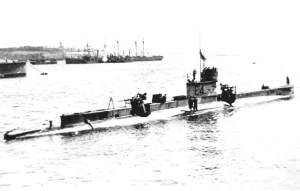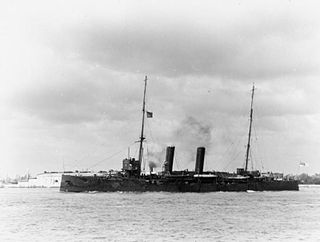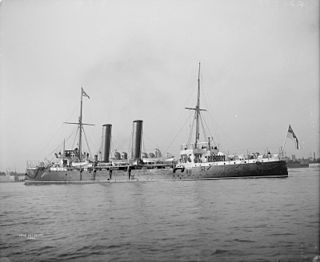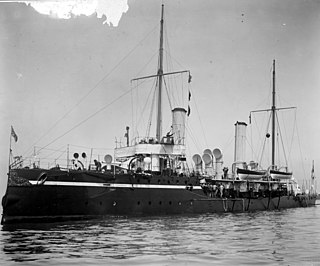
HMS Afridi was a Tribal-class destroyer of the Royal Navy launched in 1907 and sold for scrap in 1919. During the First World War she served in the North Sea and the English Channel with the 6th Destroyer Flotilla and as part of the Dover Patrol.
HMS D3 was a D-class submarine of the British Royal Navy, one of eight of this class. D3 was built by Vickers at their Barrow-in-Furness works in 1910–1911, being launched on 17 October 1910 and completed on 30 August 1911.

HMS E4 was a British E class submarine built by Vickers, Barrow-in-Furness, costing £101,900. E4 was laid down on 16 May 1911, launched on 5 February 1912 and commissioned on 28 January 1913. On 24 September 1915 E4 was attacked by the German airship SL3. On 15 August 1916, she collided with sister ship E41 during exercises off Harwich. Both ships sank and there were only 14 survivors, all from E41. Both boats were raised, repaired and recommissioned. She was sold on 21 February 1922 to the Upnor Ship Breaking Company.

HMS Sappho was an Apollo-class cruiser of the British Royal Navy which served from 1892 to 1918 in various colonial posts as well as around Britain.

HMS Conflict was the lead ship of the Conflict-class destroyers built by J. Samuel White, at East Cowes, Isle of Wight for the Royal Navy. She was launched on 13 December 1894, and entered service in 1899. After an initial spell in the Mediterranean Fleet, Conflict returned to British waters, where she served the rest of her career. Conflict was part of the Portsmouth Local Defence Flotilla during the First World War, which she survived. Conflict was sold for scrap on 20 May 1920.
HMS Syren was one of two Myrmidon-class destroyers which served with the Royal Navy. She was launched by Palmers in 1900, served in home waters and was sold off, after the First World War, in 1920.

HMS Spanker was a Sharpshooter-class torpedo gunboat of the Royal Navy. She was launched in 1889, converted to a minesweeper in 1909 and sold for breaking in 1920.

HMS Exe was a River-class destroyer ordered by the Royal Navy under the 1901–1902 Naval Estimates. Named after the River Exe in southern England flowing through Exeter in the County of Devon, she was the first ship to carry this name in the Royal Navy. She served on the China Station before World War I and in the North Sea during the war. She was sold in 1920.

HMS Latona was an Apollo-class protected cruiser of the Royal Navy which served from 1890 to 1920.
HMS Beagle was one of sixteen destroyers ordered under the 1908–09 Naval Estimates from John Brown & Company of Clydebank. Named for the English hunting dog, she was the sixth ship to carry this name since it was introduced for a Cruizer Class fir-built, brig-sloop on 8 August 1804 and sold on 21 July 1814. The destroyers of the 1908–09 program would be the last coal-fired destroyers of the Royal Navy. She and her sisters served in the First Destroyer Flotilla then were moved en masse to the Third Destroyer Flotilla and before the start of the Great War to the Fifth Destroyer Flotilla. With the advent of the convoy system they were moved to the Second Destroyer Flotilla. With the Armistice she was laid up then scrapped in 1921.

HMS Intrepid was an Apollo-class protected cruiser of the Royal Navy built on the River Clyde and launched in 1891. She was subsequently converted as a minelayer in the latter half of her career and ultimately sunk as a blockship during the Zeebrugge Raid on 23 April 1918.

HMS Circe was a Alarm-class torpedo gunboat of the British Royal Navy. She was built by Sheerness Dockyard from 1890–1893. She was converted to a minesweeper in 1908–1909 and continued these duties during the First World War. Circe was sold for scrap in 1920.
HMS Leda was an Alarm-class torpedo gunboat of the British Royal Navy. She was built by Sheerness Dockyard from 1891–1893. She was converted to a minesweeper in 1908–1909 and continued these duties during the First World War. Leda was scrapped in 1922.

HMS Speedy was a Alarm-class torpedo gunboat of the British Royal Navy. She was built by Thornycroft from 1892–1894. She was converted to a minesweeper in 1908–1909 and continued these duties during the First World War. Speedy was sunk by a German mine on 3 September 1914.

HMS Jason was a Alarm-class torpedo gunboat of the British Royal Navy. She was built by the Naval Construction & Engineering Co. from 1891–1893. She was converted to a minesweeper in 1908–1909 and continued these duties during the First World War. Jason was sunk by a German mine on 7 April 1917.
HMS Gossamer was a Sharpshooter-class torpedo gunboat of the British Royal Navy. She was built at Sheerness Dockyard from 1889–1891. She was converted to a minesweeper in 1909 and continued these duties during the First World War. Gossamer was sold for scrap in 1920.
HMS Speedwell was a Sharpshooter-class torpedo gunboat of the British Royal Navy. She was built at Devonport Dockyard from 188–1890. She was converted to a minesweeper in 1909 and continued these duties during the First World War. Speedwell was sold for scrap in 1920.
HMS Skipjack was a Sharpshooter-class torpedo gunboat of the British Royal Navy. She was built at Chatham Dockyard from 1888–1891. She was converted to a minesweeper in 1908–1909 and continued these duties during the First World War. Skipjack survived the war and was sold for scrap in 1920.
HMS TB 5 was a Cricket-class coastal destroyer or torpedo-boat of the British Royal Navy. TB 5 was built by the shipbuilder J S White from 1905 to 1907. She was used for local patrol duties in the First World War and survived the war. She was sold for scrap in 1920.

HMS Landrail was a Laforey-class destroyer of the British Royal Navy. The Laforey class was the class of destroyers ordered under the Royal Navy's 1912–1913 construction programme, which were armed with three 4-inch (102 mm) guns and four torpedo tubes and were capable of 29 knots. The ship, which was originally to be named Hotspur but was renamed before launch, was built by the Scottish shipbuilder Yarrow between 1912 and 1914,













